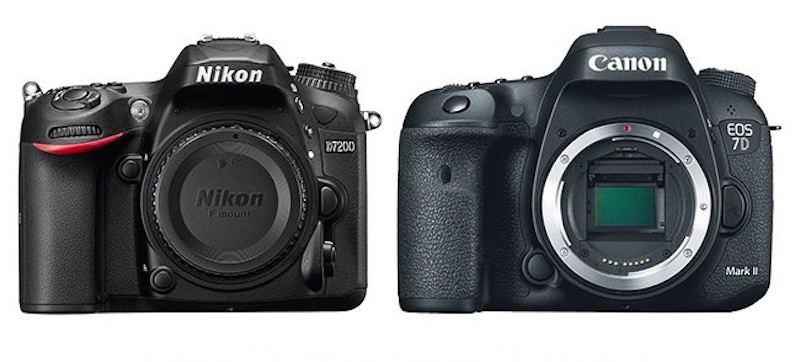Nikon D7200 vs Canon 7D Mark II Specifications Comparison
Nikon D7200 DSLR camera becomes official and replaces the D7100 with several improvements including better low-light AF system and increased buffer depth.
To see the difference between Nikon D7200 vs Canon 7D Mark II digital SLR cameras we have put together Nikon D7200 vs Canon 7D Mark II specs comparison table below.
Nikon D7200 provides a slightly improved 24.2 megapixel CMOS sensor with no optical low-pass filter powered by an EXPEED 4 image processor and comes with next-generation 51-point AF module with increased low-light sensitivity. The D7200 comes with built-in Wi-Fi with NFC and an improved 100-shot buffer depth when shooting JPEGs at 6 fps (18 14-bit or 27 12-bit Raw files).
Canon 7D Mark II features a 20.2MP CMOS sensor, Dual Digic 6 processors, next-generation Dual Pixel AF, 65 all cross-type points, 10fps max burst speed, max ISO of 16000 and built-in GPS. You can download the Instruction Manual and the AF-Setting Guide Book.
Below you can see the specs comparison table of Nikon D7200 vs Canon 7D Mark II DSLR cameras. Some differences like sensor, image size, shooting speed, lcd size etc.. detailed as bold on the table.
Nikon D7200 vs Canon 7D Mark II Specifications Comparison
| Camera Feature | Nikon D7200 | Canon 7D Mark II |
|---|---|---|
| Sensor Resolution | 24.2 Million | 20.2 Million |
| Sensor Type | CMOS | CMOS |
| Sensor Size | 23.5×15.6mm | 22.4×15.0mm |
| Sensor Pixel Size | 3.92µ | 4.09µ |
| Low Pass Filter | No | Yes |
| Sensor Dust Reduction | Yes | Yes |
| Image Size | 6,000 x 4,000 | 5,472 x 3,648 |
| Image Processor | EXPEED 4 | Dual DIGIC 6 |
| Viewfinder Type | Pentaprism | Pentaprism |
| Viewfinder Coverage | 100% | 100% |
| Viewfinder Magnification | 0.61x | 0.62x |
| Built-in Flash | Yes, with flash commander mode | Yes, with flash commander mode |
| Storage Media | 2x SD | 1x CF, 1x SD |
| Continuous Shooting Speed | 6 FPS, 7 FPS in 1.3x Crop Mode | 10 FPS |
| Buffer Size (RAW, Lossless 14-bit) | 18 | 31 |
| Continuous Shooting | 3.0 seconds | 3.1 seconds |
| Max Shutter Speed | 1/8000 to 30 sec | 1/8000 to 30 sec |
| Shutter Durability | 150,000 cycles | 200,000 cycles |
| Exposure Metering Sensor | 2,016-pixel RGB sensor 3D Color Matrix Metering II | 150,000 RGB + IR pixel metering sensor |
| Base ISO | ISO 100 | ISO 100 |
| Native ISO Sensitivity | ISO 100-25,600 | ISO 100-16,000 |
| Boosted ISO Sensitivity | ISO 51,200-102,400 (B&W only) | ISO 25,600 |
| Autofocus System | Advanced Multi-CAM 3500DX | 65-point all cross-type AF system |
| Focus Points | 51, 15 cross-type | 65 all cross-type |
| AF Detection | Up to f/8 | Up to f/8 |
| AF Detection Range | -3 to +19 EV | -3 to +19 EV |
| Flicker Detection | No | Yes |
| Video Output | MOV, MPEG-4 / H.264 | MOV, MPEG-4 / H.264 |
| Video Maximum Resolution | 1920×1080 (1080p) up to 60p | 1920×1080 (1080p) up to 60p |
| Audio Recording | Built-in microphone External stereo microphone (optional) |
Built-in microphone External stereo microphone (optional) |
| LCD Size | 3.2″ diagonal TFT-LCD | 3.0″ diagonal TFT-LCD |
| LCD Resolution | 1,228,800 dots | 1,040,000 dots |
| Built-in GPS | No | Yes |
| Wi-Fi Functionality | Built-in, with NFC | No |
| Battery | EN-EL15 Lithium-ion Battery | LP-E6N (or LP-E6) |
| Battery Life | 1,110 shots (CIPA) | 670 shots (CIPA) |
| Weather Sealed Body | Yes | Yes |
| USB Version | 2.0 | 3.0 |
| Weight (Body Only) | 675g | 820g |
| Dimensions | 135.5 × 106.5 × 76mm | 148.6 x 112.4 x 78.2mm |
| MSRP Price | $1,199.95 | $1,799.00 |
Conclusion
From the specs list comparison above, it’s clear that the Canon 7D Mark II is a higher-grade camera than the Nikon D7200. That’s why these cameras have $600 price difference.
The high-end DX-format camera, long-rumored Nikon D400 might be the real competitor to the 7D Mark II. If we see those days the price of the Nikon D400 will probably stand the same price as the 7D Mark II.
The main difference between the Nikon D7200 vs Canon 7D Mark II is the continuous shooting speed. The 7D Mark II has a faster 10 fps and the D7200 has 6 fps. For the buffer size comparison you fill the buffer on 7D Mark II with 31 RAW images and on D7200 you can shoot 18 RAW images.
Finally we can say the Nikon D7200 is not a direct competitor against the Canon’s 7D Mark II, and there is still room for a high-end Nikon DX DSLR. If Nikon puts a large buffer with 10 fps continuous shooting speed than it will sure be interesting to see how it will compare to the 7D Mark II.









